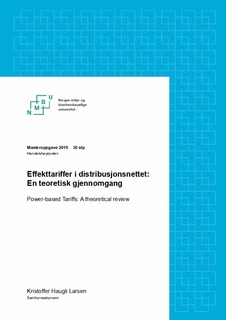| dc.contributor.advisor | Bergland, Olvar | |
| dc.contributor.author | Larsen, Kristoffer Haugli | |
| dc.coverage.spatial | Norway | nb_NO |
| dc.date.accessioned | 2019-08-28T08:20:40Z | |
| dc.date.available | 2019-08-28T08:20:40Z | |
| dc.date.issued | 2019 | |
| dc.identifier.uri | http://hdl.handle.net/11250/2611310 | |
| dc.description.abstract | Dagens tariffstruktur avregner konsumentene etter deres energikonsum over tid. Overføringsnettet dimensjoneres imidlertid etter momentan belastning gjennom konsumentenes samlede effektuttak innenfor et område, og en avregning etter energikonsumet kan dermed gi feilaktige prissignaler om kostnadene de påfører nettet. En overgang fra dagens energibaserte avregning til ny tariffstruktur med effektbasert avregning kan dermed bidra til at tariffene i større grad reflekterer kostnadene konsumentene utløser med sitt konsum, som gjør at man kan oppnå en mer korrekt tilpasning fra konsumentene. Med bakgrunn i dette har jeg i denne oppgaven sett på Norges vassdrags- og energidirektorats (NVE) tre forslag til ny tariffstruktur: Målt effekt, tidsavhengig energiledd og abonnert effekt. Diskusjonen i oppgaven fokuserer på om de tre alternativene kan bidra til rettferdig kostnadsfordeling mellom konsumentene, og om de kan bidra til effektiv utnyttelse og utvikling av nettet, fra et samfunnsøkonomisk synspunkt. | nb_NO |
| dc.description.abstract | Todays tariff system calculates the consumers tariff costs based on energy consumption over time. The capacity of the transmission grid however depends on the instantaneous load thru consumers total power extraction within an area. Thus, calculating the tariffs based on energy consumption can give misleading price signals to the consumers regarding the costs they are inflicting on the grid. Hence, by transitioning from energy based tariffs to power based tariffs the prices can more accurately reflect the costs the consumers are inflicting on the grid thru their consumption, and we can achieve an improvement in the consumers adaption. Based on this, I have in this thesis considered the three proposals to new tariff system from The Norwegian Water Resources and Energy Directorate (NVE): Measured power extraction, time of use and subscribed power extraction. The thesis’ discussion are focused on the alternatives’ ability to achieve fair distribution of costs between consumers, and whether they can achieve efficient utilization and development of the grid, from a socio-economic point of view. | nb_NO |
| dc.language.iso | nob | nb_NO |
| dc.publisher | Norwegian University of Life Sciences, Ås | nb_NO |
| dc.rights | Attribution-NonCommercial-NoDerivatives 4.0 Internasjonal | * |
| dc.rights.uri | http://creativecommons.org/licenses/by-nc-nd/4.0/deed.no | * |
| dc.subject | Effekttariffer | nb_NO |
| dc.subject | Nettleie | nb_NO |
| dc.title | Effekttariffer i distribusjonsnettet : en teoretisk gjennomgang | nb_NO |
| dc.title.alternative | Power-based tariffs : a theoretical review | nb_NO |
| dc.type | Master thesis | nb_NO |
| dc.description.version | submittedVersion | nb_NO |
| dc.subject.nsi | VDP::Social science: 200::Economics: 210::Economics: 212 | nb_NO |
| dc.source.pagenumber | 96 | nb_NO |
| dc.description.localcode | M-ECON | nb_NO |

